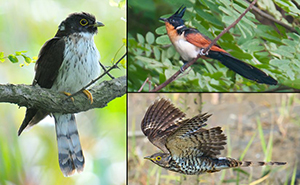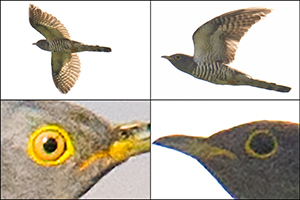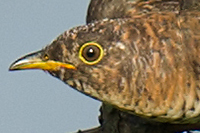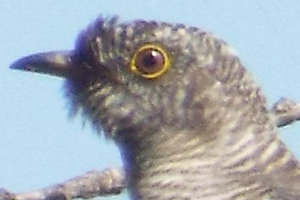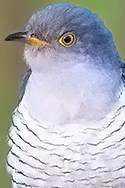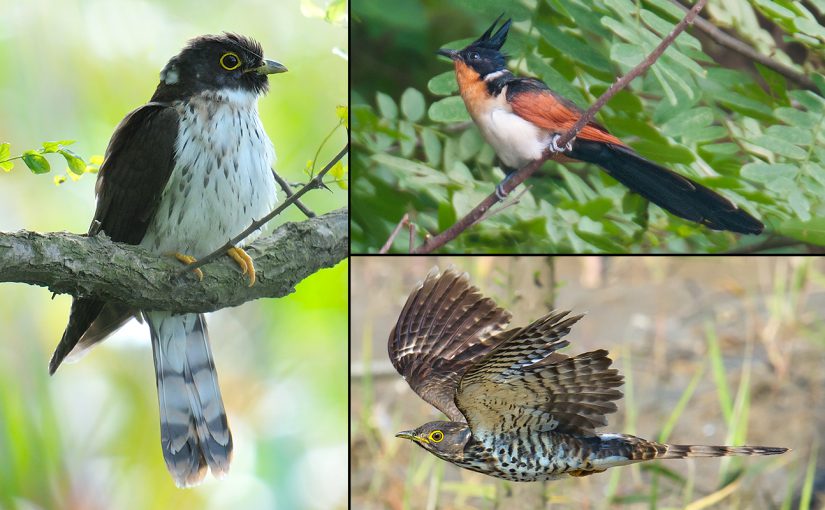The image above shows three cuckoos of the Shanghai region. Clockwise from L: Rufous Hawk-Cuckoo, Chestnut-winged Cuckoo, and Large Hawk-Cuckoo. Join us as we study the rich array of cuckoos that passes through Shanghai.
by Craig Brelsford
Founder, shanghaibirding.com
It is spring, and one of the most thrilling moments of the bird migration in Shanghai is upon us—the passage of the Cuculinae, the Old World brood-parasitic cuckoos. Nowhere in the world is the diversity of this group greater than in eastern Eurasia, and here in Shanghai we get an enviable selection. Let us examine our Shanghai-area parasitic cuckoos and learn how to tell them apart.
We can divide the Shanghai-area brood-parasitic cuckoos into two categories: the mainly grey, slender-bodied Cuculus cuckoos and the non-Cuculus cuckoos. We will look at the non-Cuculus cuckoos first.
MASTER MIMICS: THE HAWK-CUCKOOS
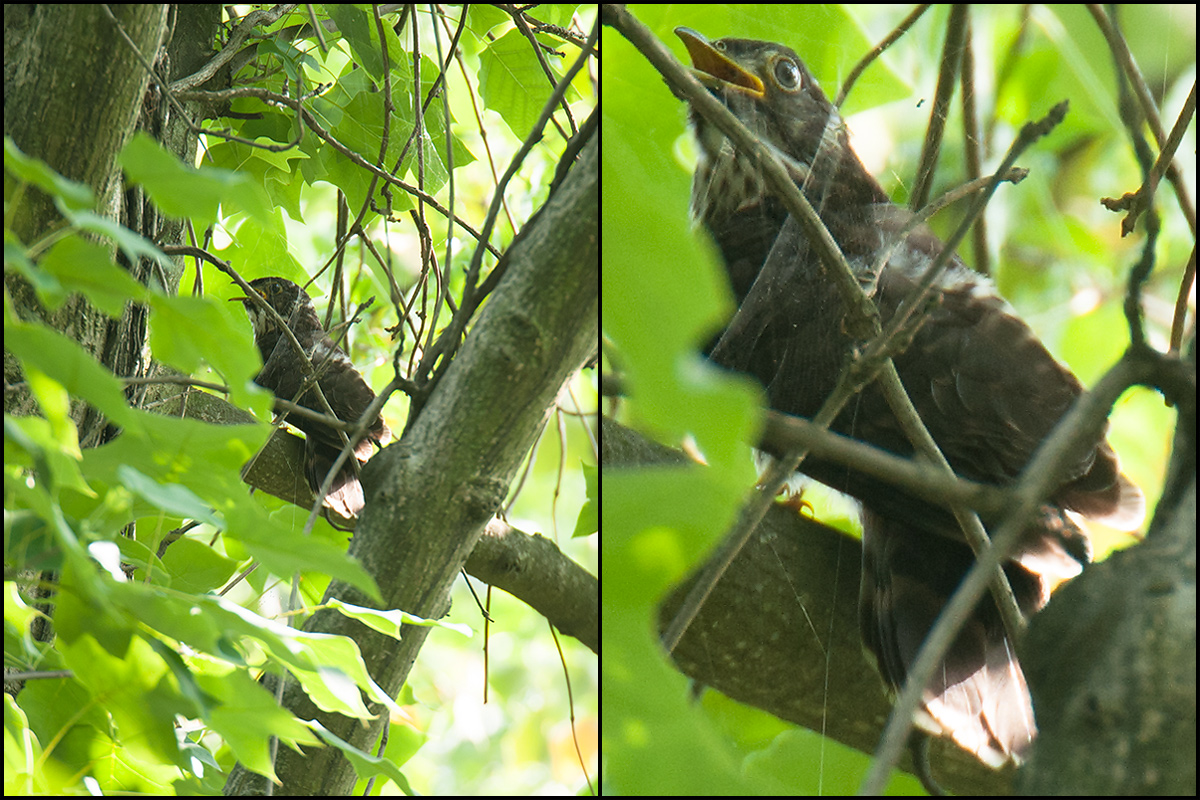
The non-Cuculus parasitic cuckoo that one is most likely to see in Shanghai is Large Hawk-Cuckoo Hierococcyx sparverioides. In the microforests at Cape Nanhui and once, to my surprise, in inner-city Zhongshan Park, I have heard the scream of “Brain fever!” The species breeds in nearby Jiangsu and Zhejiang.
The hawk-cuckoos mimic sparrowhawks, an amazing feat of evolution. The resemblance serves, scientists say, not to increase stealth but to decrease it. Passerines, mistaking the intruder for a sparrowhawk, mob it, thereby giving away the location of their nest. After the tumult dies down, the hawk-cuckoo quietly swoops in and lays her egg.
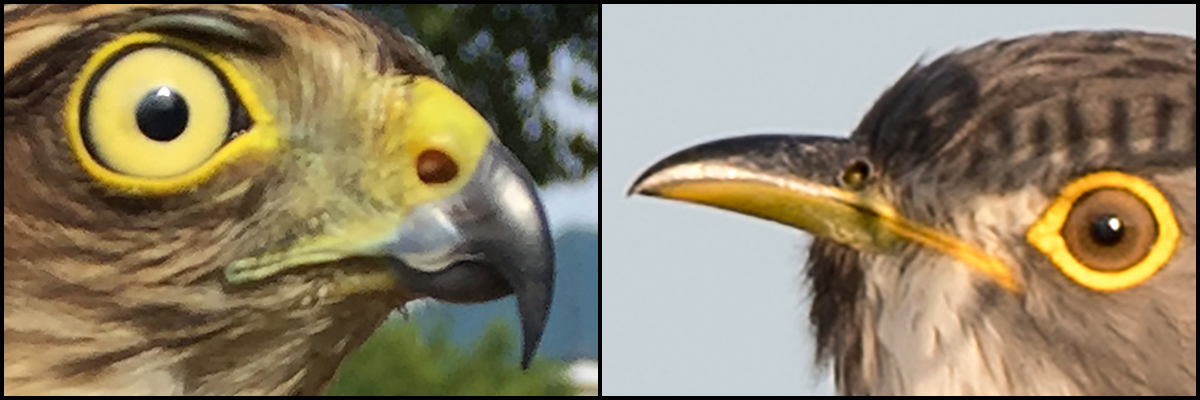
When it comes to the business of eating, however, the masquerade ends. The hooked bill of a sparrowhawk is a butcher’s tool, made for stripping the flesh of vertebrates from bone. The bill of a hawk-cuckoo is blunt, the utensil of a caterpillar-eater. Need a quick differentiator between “sprock” and hawk-cuckoo? Look to the bill.
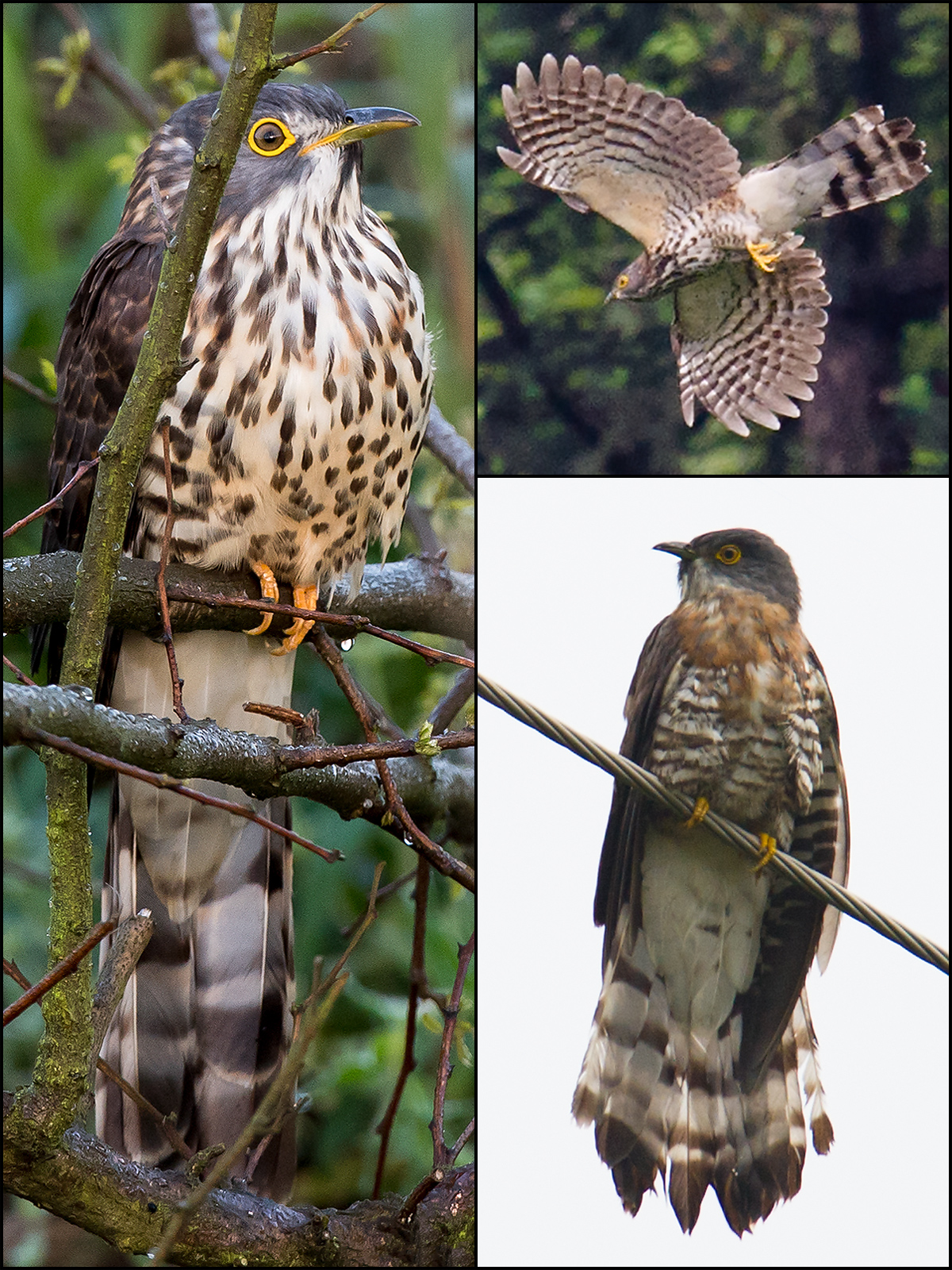
Another separation we Shanghai birders need to make is that between Large Hawk-Cuckoo and Rufous Hawk-Cuckoo Hierococcyx hyperythrus. If seen clearly, adult Large Hawk-Cuckoo and Rufous Hawk-Cuckoo are readily separable. Rufous Hawk-Cuckoo shows a belly washed rufous with faint streaks. Large Hawk-Cuckoo is heavily barred and streaked and has the rufous coloring confined to the upper breast.
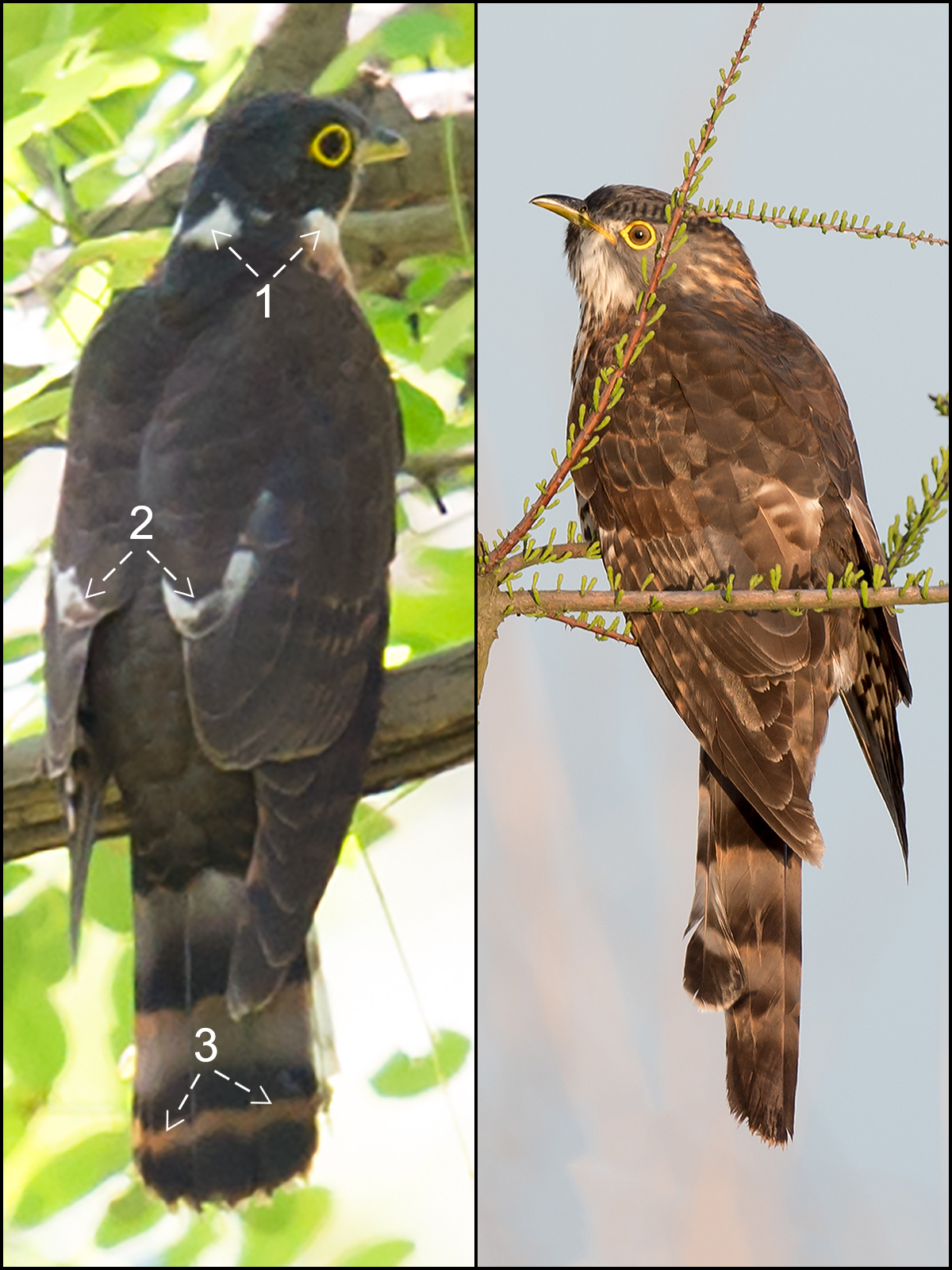
Adult Rufous Hawk-Cuckoo shows a white spot on the nape, white neck-sides, and white scapular crescents. These features may also be visible in sub-adult Rufous Hawk-Cuckoo. Large Hawk-Cuckoo shows none of these in any plumage.
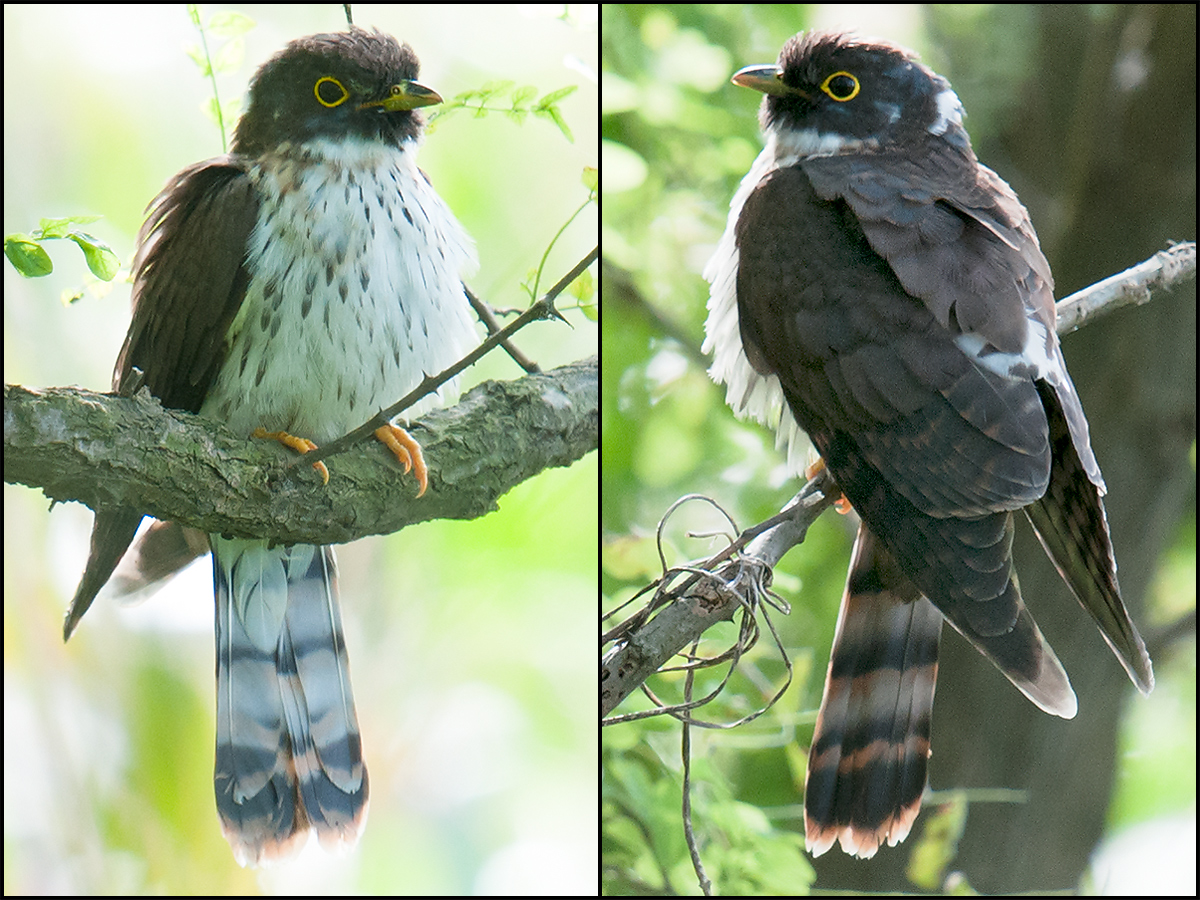
Size differences may be appreciable. An average Large Hawk-Cuckoo is 15 percent larger than Rufous Hawk-Cuckoo. The tails differ, with the black subterminal band of Rufous Hawk-Cuckoo being bordered by a rufous line above and by the rufous tail-tip below. These rufous areas may be visible in immature cuckoos.
ASIAN KOEL AND CHESTNUT-WINGED CUCKOO
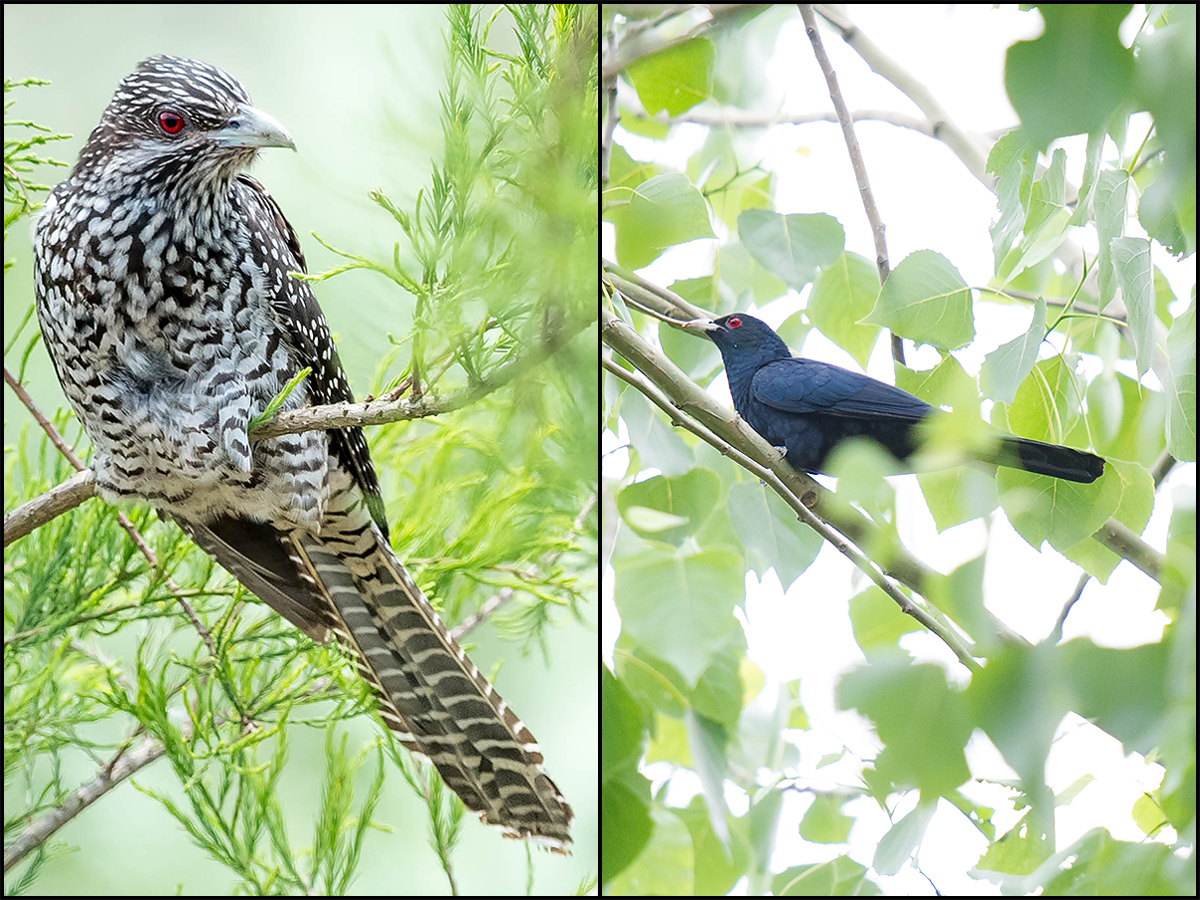
The other non-Cuculus parasitic cuckoos of the Shanghai region are Asian Koel Eudynamys scolopaceus and Chestnut-winged Cuckoo Clamator coromandus. Neither poses great ID challenges.
In China, Asian Koel ssp. chinensis breeds mainly south of the Yangtze River. With its familiar “koh-EL” song, Asian Koel is as easy to hear as it is hard to see in the dense forests where it is almost invariably found. It shows strong sexual dimorphism, with the male entirely glossy bluish-black and the female brown with whitish streaks, bars, and spots.
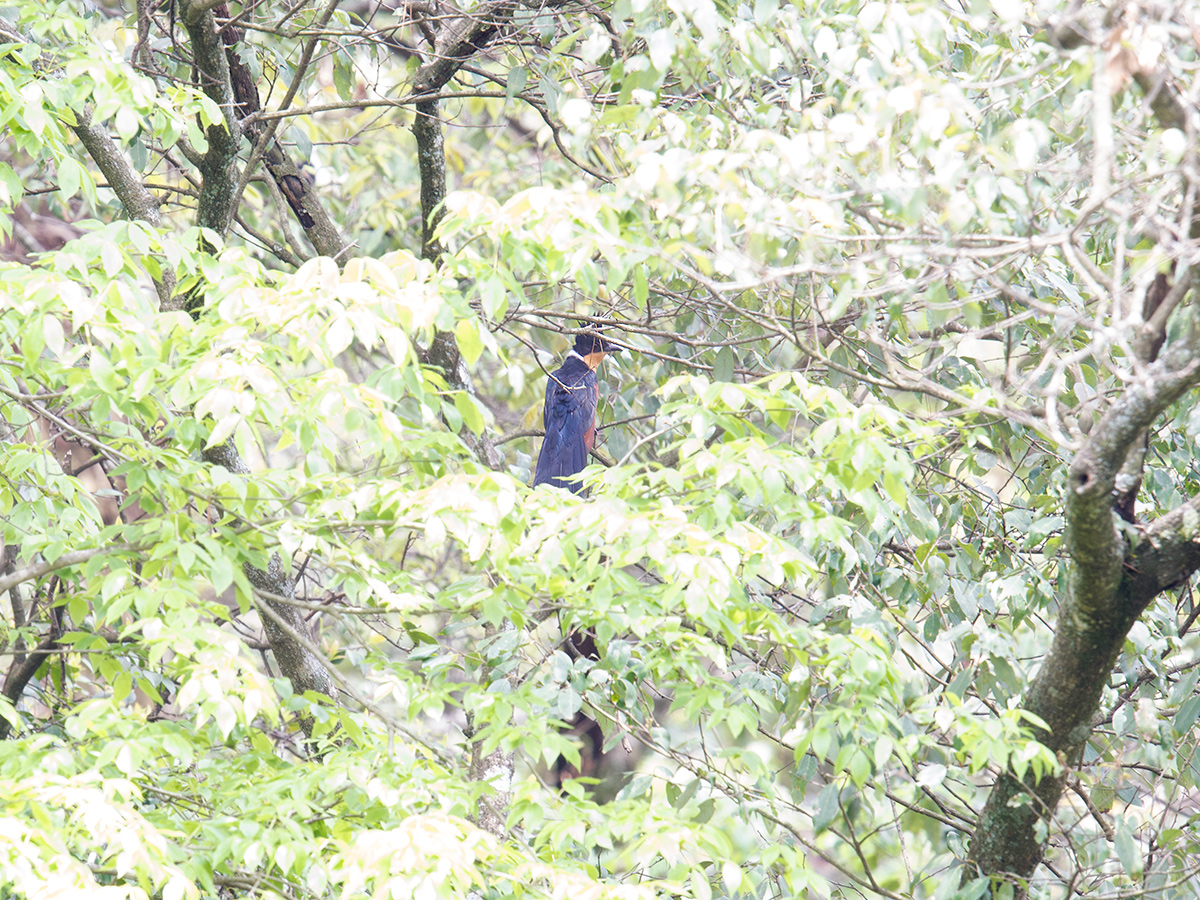
I have yet to see Chestnut-winged Cuckoo in Shanghai, but others have noted it at Cape Nanhui. I have seen the species at Laoshan (32.071265, 118.560699) in Nanjing as well as in Zhejiang in the Tianmu Mountains (30.344148, 119.440201). With its glossy-black erectile crest, rufous wings, and long, black tail, the species is unmistakable—if you can manage to see it.
SHANGHAI-AREA CUCULUS CUCKOOS
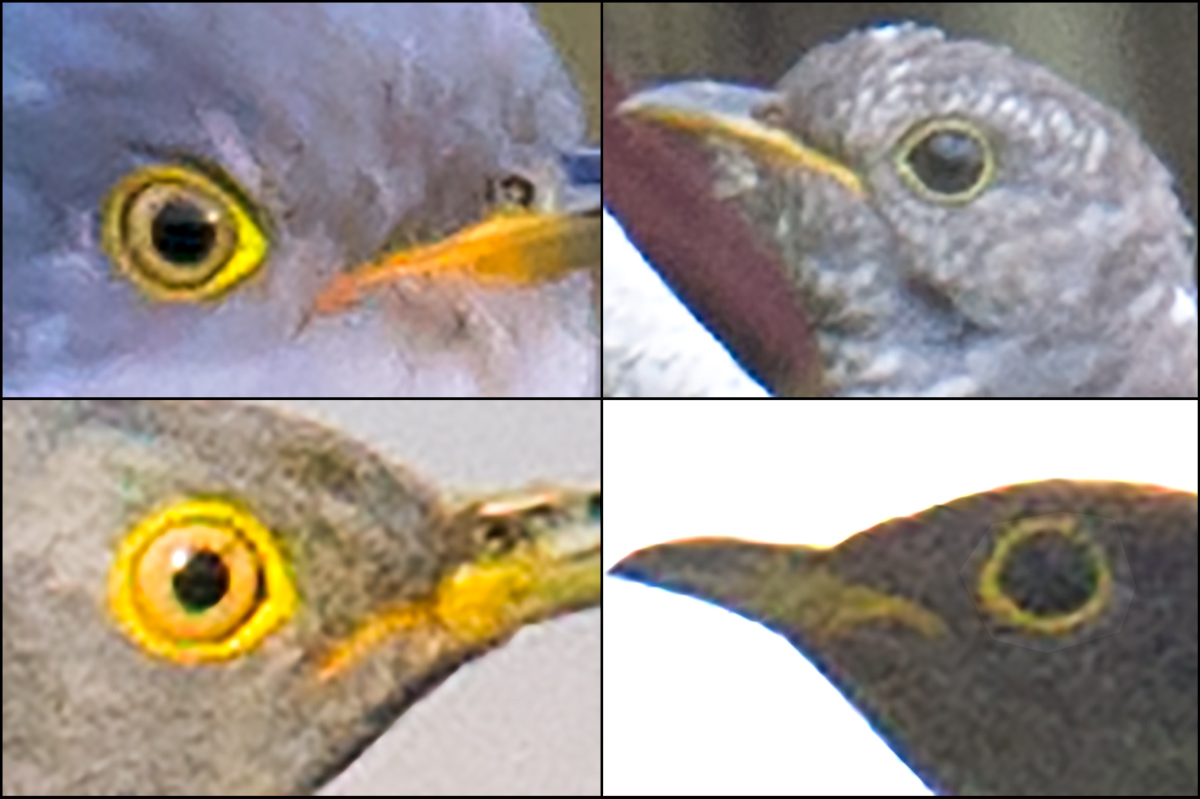
Five Cuculus cuckoos have been claimed for Shanghai: Lesser Cuckoo Cuculus poliocephalus, Indian Cuckoo C. micropterus, Himalayan Cuckoo C. saturatus, Oriental Cuckoo C. optatus, and Common Cuckoo C. canorus.
The latter breeds in the area, parasitizing the nests of Oriental Reed Warbler in the reed beds at Cape Nanhui. Its famous song, perhaps the best-known bird sound in the world, is hard to miss at Nanhui in May.
Lesser Cuckoo and Indian Cuckoo breed in the region and are recorded on passage in Shanghai. Himalayan Cuckoo and Oriental Cuckoo may pass through Shanghai, but as in size, plumage, and bare parts they are nearly identical to each other and very close to Common Cuckoo, and because they rarely (if ever) sing in our region, it is very difficult to know how common they are.
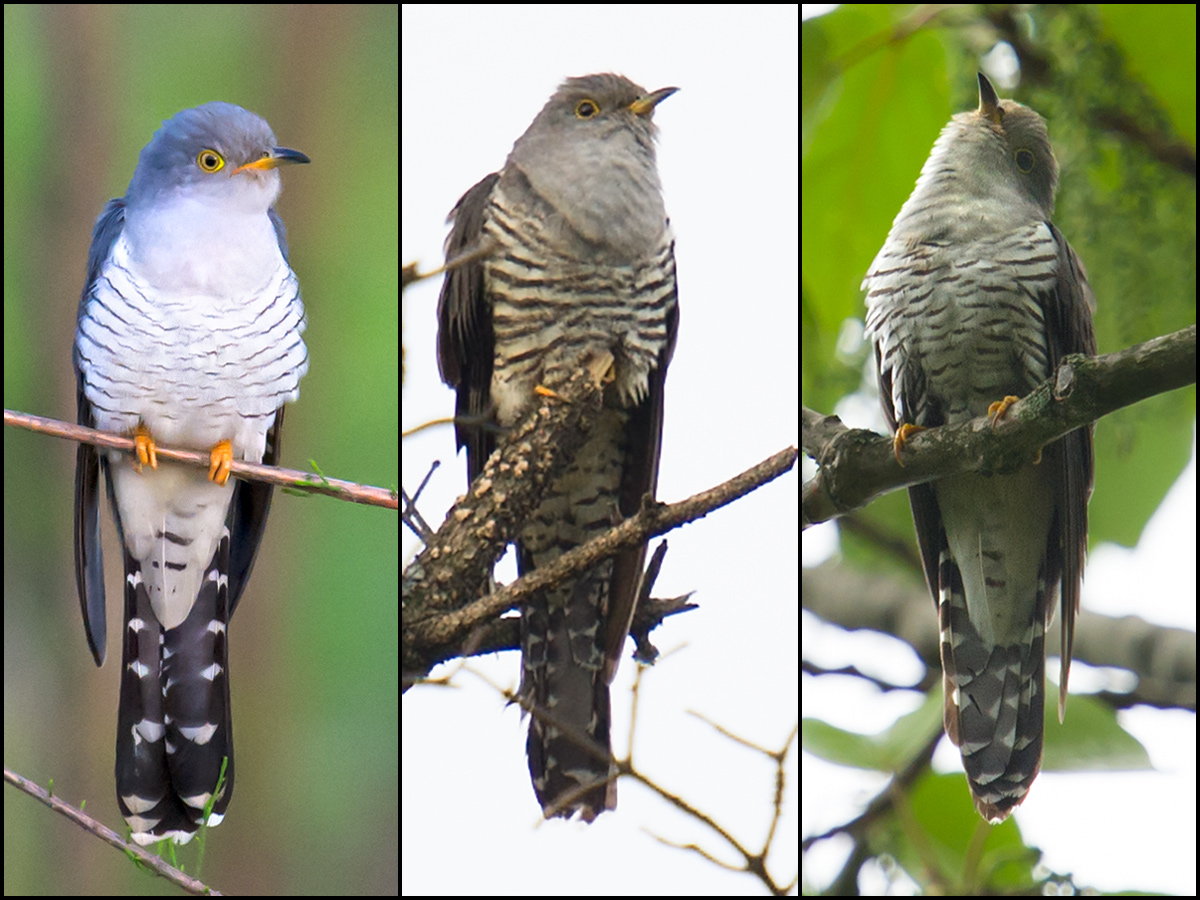
Hear the song of any of these Cuculus, and you will have your ID; even the similar songs of Himalayan and Oriental are readily separable. If your cuckoo is silent, however, then you will need a closer look. Lesser Cuckoo and Indian Cuckoo have a brown iris, Common Cuckoo a bright-yellow iris. Lesser Cuckoo is the size of a thrush; Indian Cuckoo is a third larger; Common Cuckoo is larger still, approaching the size of a female Eurasian Sparrowhawk.
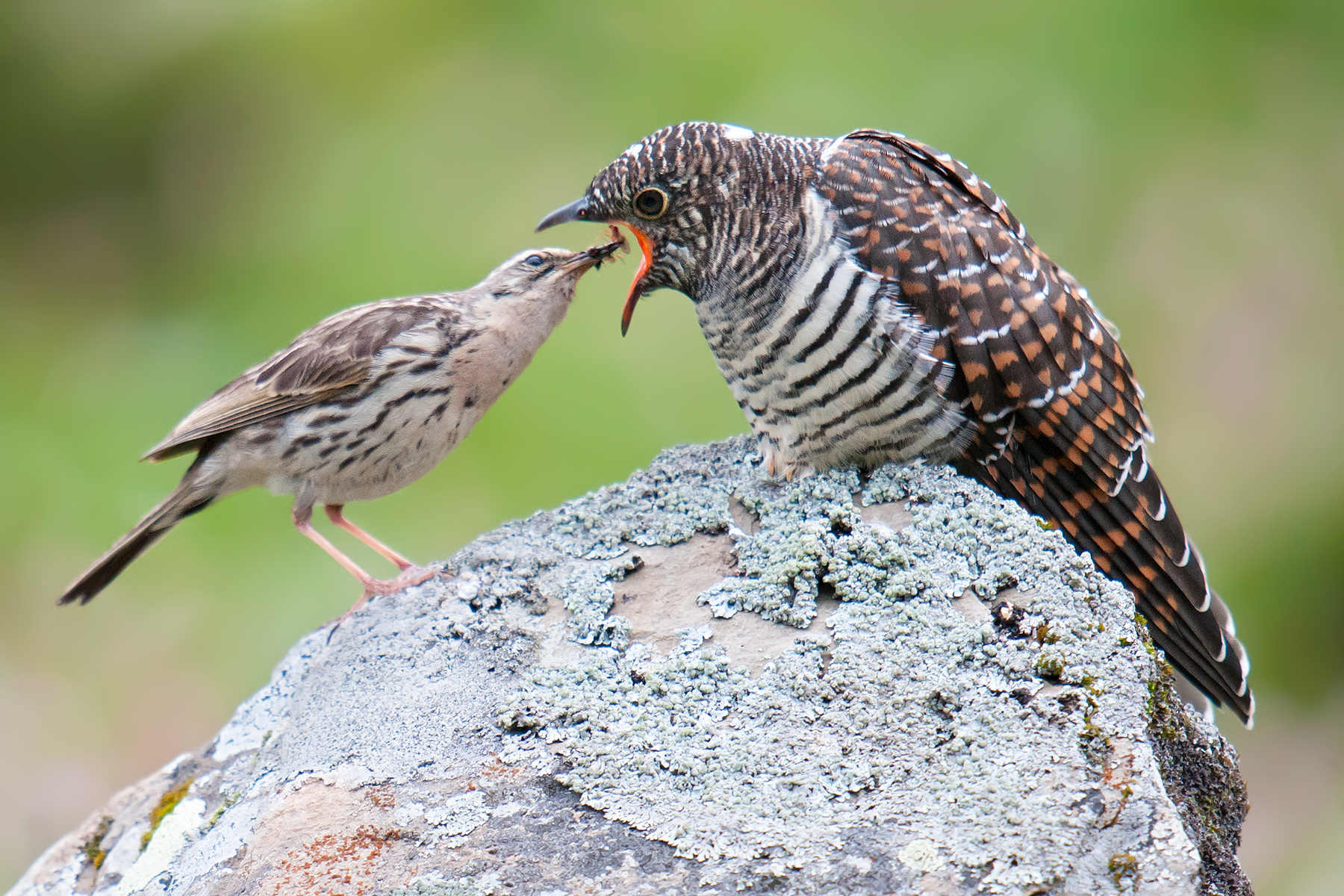
In autumn, juveniles pass through Shanghai. They are silent and nearly impossible to identify to species. If one gets a close look at juvenile Lesser Cuckoo, however, one may appreciate its thrush-like size. If you happen to be on the breeding grounds, then you can attempt an ID according to the species of the foster parent.
NON-CUCULINAE CUCKOOS
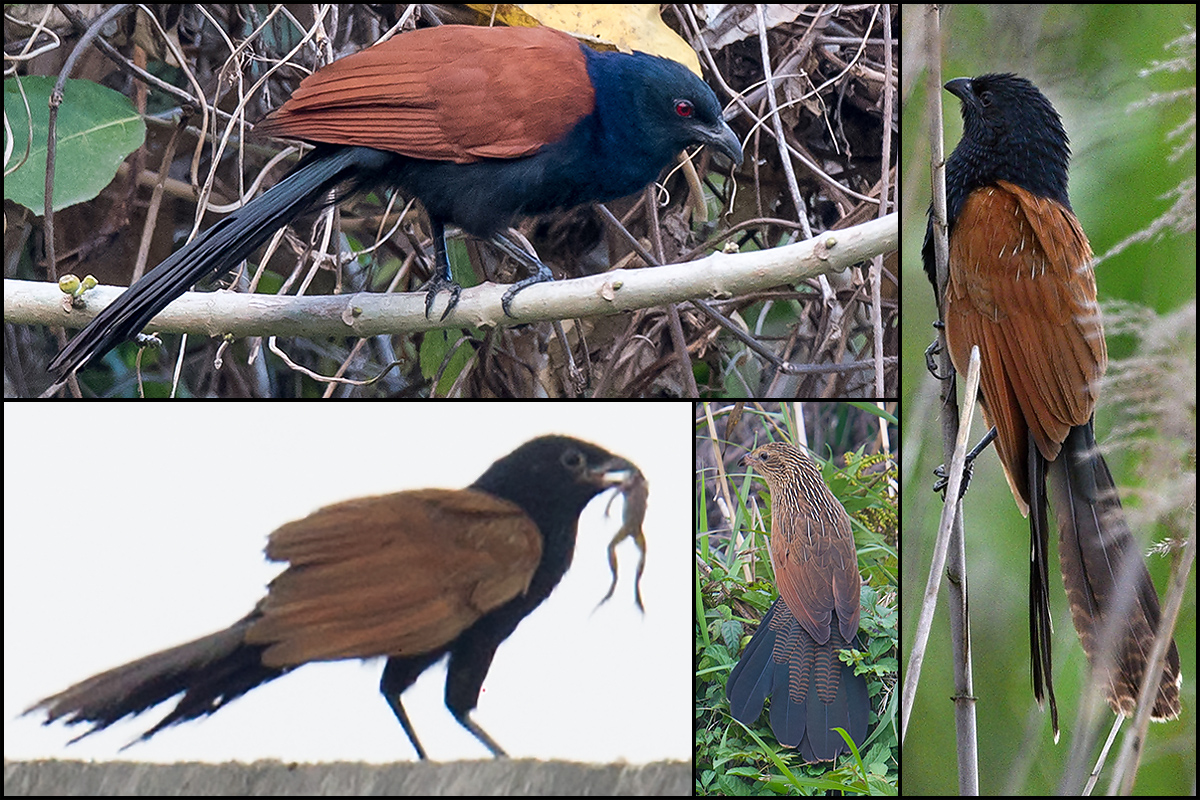
Lesser Coucal Centropus bengalensis is the good guy among the cuckoos of Shanghai. Unlike all the other cuckoos recorded in Shanghai, but like most of the cuckoos in the world, the coucals are not brood parasites. Lesser Coucal, resident in Shanghai, builds a dome nest on the ground.
Lesser Coucal may be the only non-Cuculinae cuckoo in Shanghai, but it shares at least one trait with the brood parasites: It is very unobtrusive. Look for Lesser Coucal in areas of thick vegetation near water, such as the strips of reed bed along the canals at Cape Nanhui. If you find one, count yourself lucky.
Greater Coucal Centropus sinensis occurs south of our region. It is nearly half again as large as Lesser Coucal and has a cleaner and glossier mantle, a thicker bill, and a redder iris.
RESOURCES ON CUCKOOS
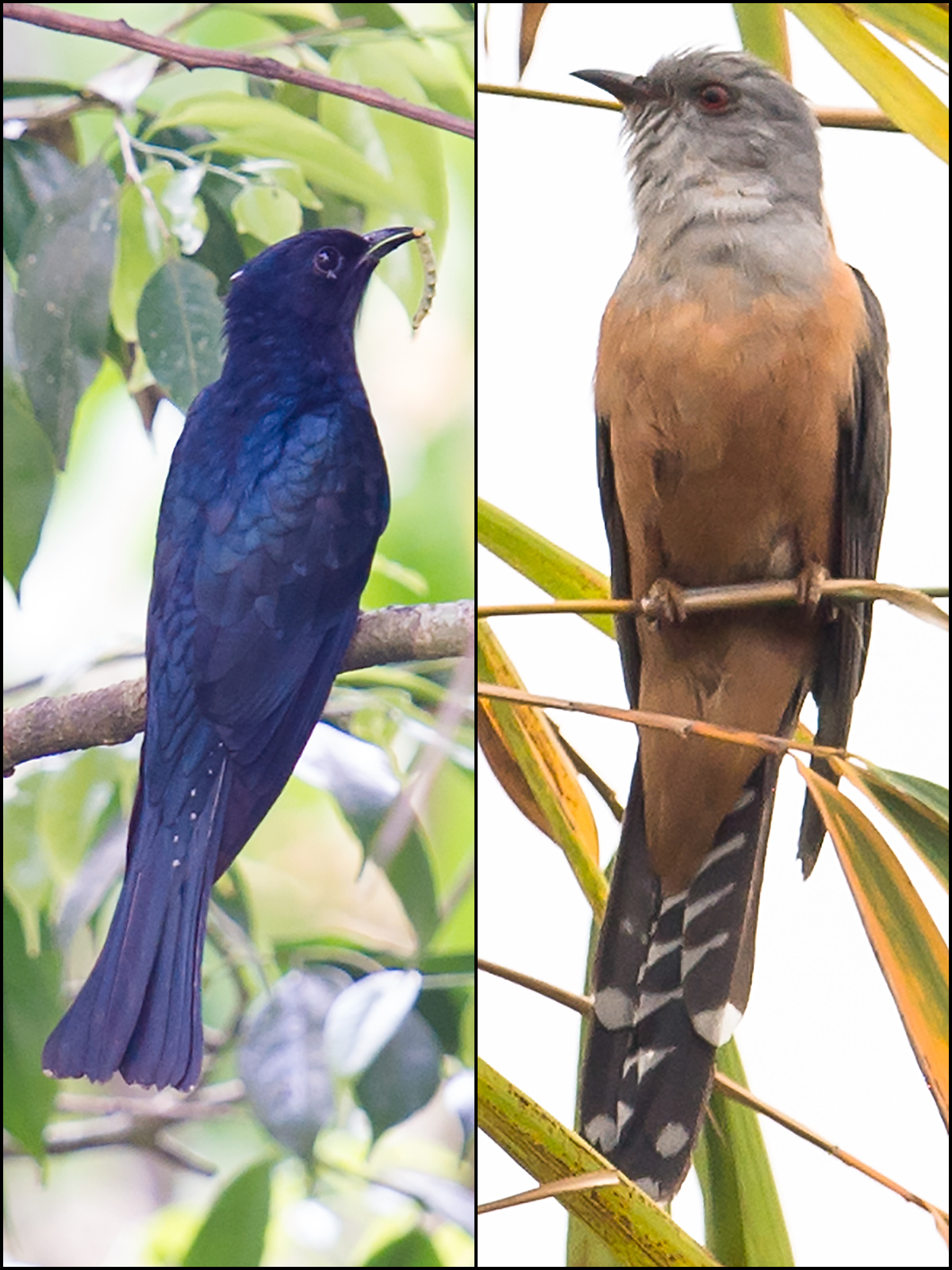
The Sounds of Shanghai’s Cuckoos, by Craig Brelsford
All cuckoos from the Shanghai area are covered here. I make my recordings with my Olympus DM-650.
Lesser Coucal, Centropus bengalensis, Jiangsu, June (00:06; 1.1 MB)
Chestnut-winged Cuckoo Clamator coromandus, West Tianmu Mountain Nature Reserve, Zhejiang, May (00:43; 3.3 MB)
Asian Koel Eudynamys scolopaceus, Jiangsu, May (00:39; 2.4 MB)
Large Hawk-Cuckoo Hierococcyx sparverioides, Sichuan, June (03:21; 4 MB)
Rufous Hawk-Cuckoo Hierococcyx hyperythrus, Heilongjiang, June (01:06; 3.4 MB)
Lesser Cuckoo Cuculus poliocephalus, Sichuan, June (00:16; 1 MB)
Indian Cuckoo Cuculus micropterus, classic four-note song plus bubbly flourish, Heilongjiang, June (00:02; 901 KB)
Himalayan Cuckoo Cuculus saturatus, singing and quarreling, Sichuan, June (00:28; 1.2 MB)
Oriental Cuckoo Cuculus optatus, classic double note “boop boop” faintly from a distance, Heilongjiang, May (00:03; 600 KB)
Common Cuckoo Cuculus canorus, classic song plus cough, Cape Nanhui, Shanghai, May (00:03; 913 KB)
REFERENCES
Brazil, Mark. Birds of East Asia. Princeton University Press. Cuckoos, pp. 254-9.
del Hoyo, Josep, et al., eds. The Handbook of the Birds of the World. Lynx Edicions. Vol. 4, “Sandgrouse to Cuckoos.” Cuculidae (pp. 508-607) by R. B. Payne.
MacKinnon, John & Karen Phillipps. A Field Guide to the Birds of China. Oxford University Press.
Featured image: Clockwise from L, Rufous Hawk-Cuckoo Hierococcyx hyperythrus, Jiangsu, October; Chestnut-winged Cuckoo Clamator coromandus, Jiangsu, July; and Large Hawk-Cuckoo Hierococcyx sparverioides, Cape Nanhui, Shanghai, May. (Craig Brelsford)

